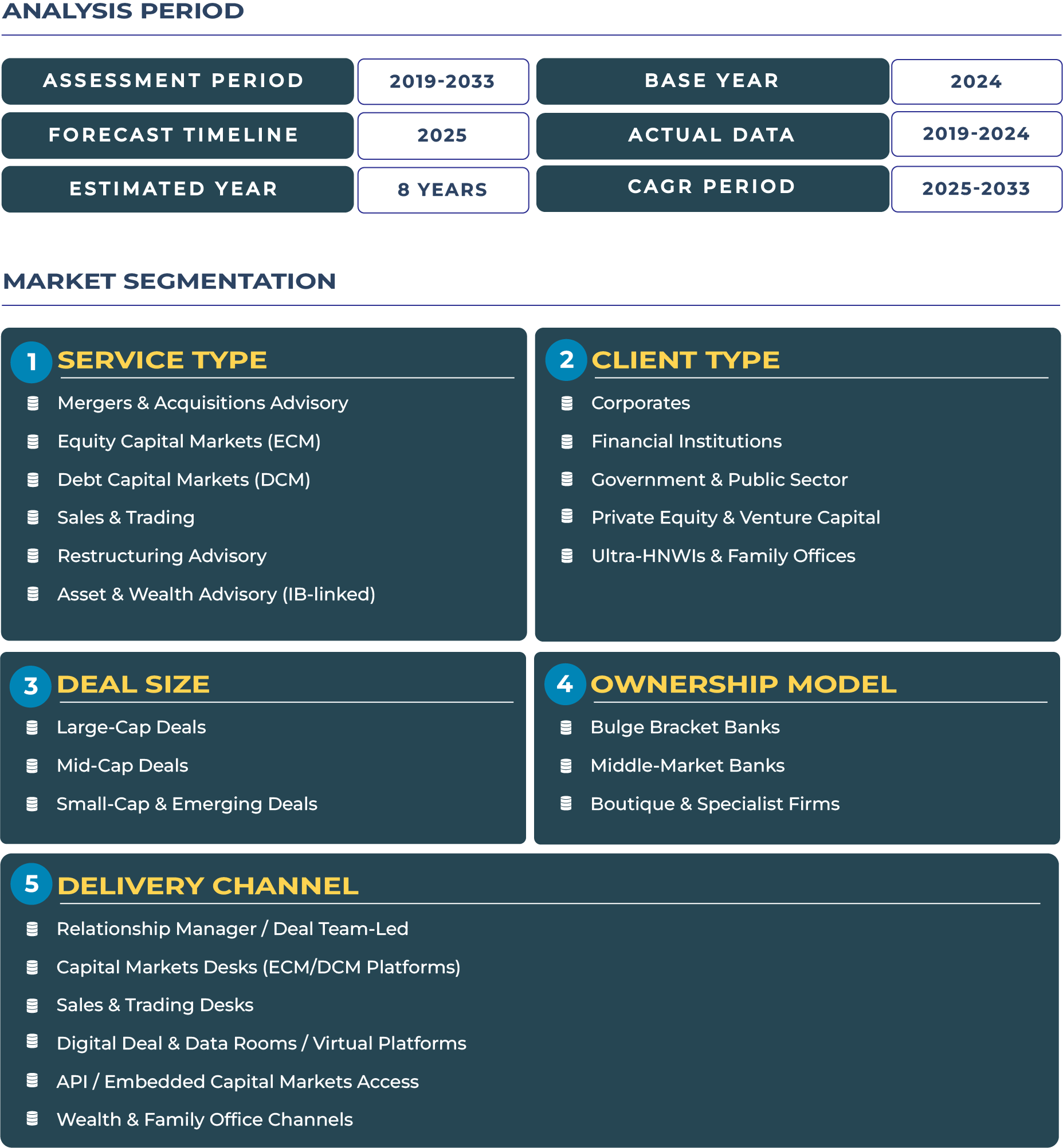Advisory Momentum in Italy Investment Banking Sector: Privatizations and Infrastructure Lead the Charge
Italy investment banking landscape is entering a phase shaped by state-driven infrastructure programs, privatization pipelines, and renewed interest in capital markets activity. As the government accelerates asset divestments and public–private partnerships, advisory firms are positioning themselves to capture mandates across transportation, digital infrastructure, utilities, and strategic assets. This transition is opening opportunities for both international banks and domestic institutions to structure financing, manage valuations, and advise on mergers and acquisitions linked to restructuring and privatization. With increased funding avenues from the European Union’s recovery programs and capital injections into large-scale projects, the investment banking industry is refining its services to address complex regulatory procedures, stakeholder management, and cross-border investment facilitation.
Note:* The market size refers to the total revenue generated by banks through interest income, non-interest income, and other ancillary sources.
Italy Investment Banking Market Outlook: Infrastructure Advisory and Privatization-Driven Investment Banking Expansion
The Italy Investment Banking Market is projected to rise from USD 8.4 billion in 2025 to USD 10.4 billion by 2033, at a compounded annual growth rate of approximately 2.7%. Growth is supported by robust advisory demand for public infrastructure transactions, corporate restructuring, and divestment mandates involving large utility and transport networks. The Italian government has intensified plans to privatize stakes in select state-owned enterprises, stimulating advisory and capital markets activities. EU funding frameworks and sustainability-linked financing compel banks to develop expertise in structuring deals compliant with environmental and digital transformation goals. At the same time, mid-market enterprises are seeking capital restructuring, debt refinancing, and cross-border partnerships to enhance competitiveness, fueling growth across equity capital markets, restructuring advisory, and debt capital markets. Institutions such as the Ministry of Economy and Finance drive clarity on divestment targets, while corporate banking arms reposition investment banking units to cater to infrastructure sponsors, family-owned enterprises, and strategic investors.
Drivers & Restraints: Infrastructure Ambition vs. Political Volatility
Growth Drivers: One of the strongest catalysts for investment banking activity in Italy is the rise in privatizations and infrastructure expansion. Government-led divestment of legacy assets, including ports, transportation corridors, energy grid assets, and telecom infrastructure, continues to create advisory opportunities. Major banks are engaging in transaction structuring, valuation, and syndication for projects involving strategic investors across Europe and beyond. Additionally, increased commitments to modernize regional logistics, water systems, and digital infrastructure have led to growing demand for debt and equity financing solutions. Institutional investors seeking yield in stable, long-term public assets are catalyzing transaction volumes, while mid-market merger and acquisition advisory gains momentum through succession planning and corporate transformation.
Restraints: Despite these tailwinds, political instability and governance fluctuations can slow investment flows. Shifts in coalition priorities and changing regulatory positions risk delaying privatization timelines and deterring foreign investors. Concerns around long-term fiscal sustainability and public debt add pressure on capital allocation and increase scrutiny of large-scale deals. Additionally, legal complexities and approval delays, particularly for transactions involving strategic infrastructure, may dampen investor appetite. These factors can restrict momentum in deal pipelines and necessitate more robust risk management and contingency planning across investment banking activities.
Trends & Opportunities: Fintech Integration and Cross-Border Deal Structuring
Emerging Trends: Italy is observing increased collaboration between investment banks and fintech platforms to accelerate deal origination, enhance capital markets access, and streamline cross-border workflows. Digital platforms for private placements, corporate debt issuance, and investor matchmaking are entering mainstream adoption, especially among mid-sized firms seeking quicker access to capital. Technology-enabled analytics and due diligence tools are also becoming central to restructuring and merger and acquisition advisory. In parallel, sustainability-linked bonds and green financing structures are gaining traction, aligning investment banking services with the EU’s climate transition goals.
Opportunities: Significant opportunities lie in cross-border advisory for infrastructure investments, especially involving telecommunications, digital corridors, energy transition assets, and transport networks. Foreign institutional investors are exploring acquisitions and joint ventures with Italian firms, creating demand for transaction advisory, debt syndication, and capital restructuring services. Investment banks can strengthen their role by offering specialized teams to handle regulatory compliance, ESG-linked financing instruments, and public–private partnerships across multiple regions. The emergence of mid-market private equity firms sourcing Italian acquisitions further drives merger and acquisition advisory opportunities, particularly in northern industrial hubs and service-oriented sectors.
Competitive Landscape: Strategic Advisory, Infrastructure Mandates, and Market Positioning
Italy investment banking ecosystem comprises regional banks, European financial institutions, and international firms, each competing for mandates in infrastructure, privatization, and restructuring services. A recent development involving Ministero delle Imprese e del Made in Italy and the national telecom infrastructure spotlighted tensions with foreign investors engaged in strategic asset bids. For example, the ongoing situation involving Italy and KKR over telecom network ownership reflects the strategic importance of corporate advisory in politically sensitive sectors. Banks are adjusting by developing expert teams focusing on infrastructure transactions, capital markets strategy, and privatization advisory. They are also building capacity to structure green bonds, hybrid capital instruments, and sustainability-linked debt products tailored for infrastructure sponsors and state-backed projects. These evolving strategies enable firms to capture value in sectors undergoing transformation and regulatory shifts.







